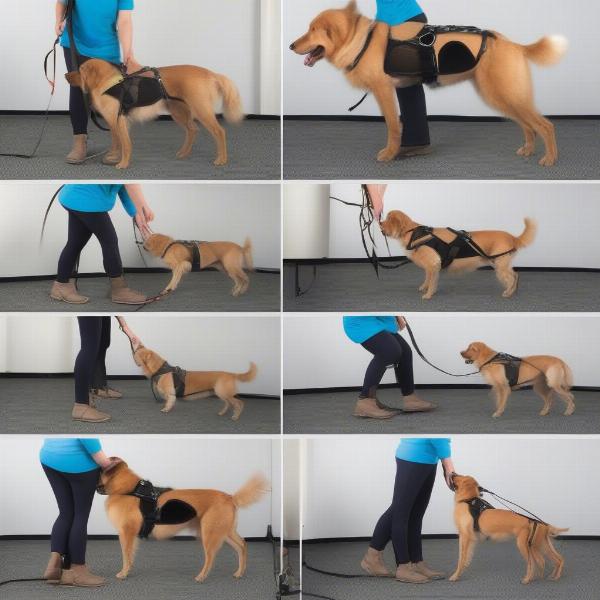A dog harness for rear support can be a lifesaver for senior dogs, dogs recovering from surgery, or those with mobility issues. These harnesses provide support and stability, helping your furry friend navigate stairs, get into cars, or simply stand up. Choosing the right harness is crucial for your dog’s comfort and well-being. This guide provides everything you need to know about selecting, using, and caring for a rear support harness.
Choosing the Right Rear Support Harness for Your Dog
Several factors influence the choice of a suitable rear support harness. Consider your dog’s size, weight, and the specific area needing support. Is it just the hind legs, or does your dog require full-body support? For dogs recovering from surgery, a full-body harness can restrict movement around the incision site, promoting healing. If your dog struggles with stairs, a harness with handles can provide you with better control and leverage.
Types of Rear Support Harnesses
- Lifting Harnesses: These harnesses have handles on the back and/or under the belly, allowing you to lift and support your dog’s hindquarters or entire body. They are ideal for assisting with stairs, getting in and out of cars, and supporting weak legs.
- Support Slings: These slings provide support specifically for the hind legs, helping dogs with hip dysplasia, arthritis, or other mobility issues. They are generally less restrictive than full-body harnesses.
- Wheelchair Harnesses: These are designed for dogs with limited mobility in their hind legs and are used in conjunction with a dog wheelchair.
Sizing and Fit
Getting the correct size is vital for your dog’s comfort and the effectiveness of the harness. Always measure your dog carefully, following the manufacturer’s instructions. A harness that’s too tight can restrict movement and cause discomfort, while a harness that’s too loose can be ineffective and even dangerous.
Using a Rear Support Harness Effectively
 How to Properly Put on a Dog Rear Support Harness
How to Properly Put on a Dog Rear Support Harness
Introducing a rear support harness should be a gradual process. Start by letting your dog sniff and explore the harness. Then, put it on for short periods, gradually increasing the duration as your dog becomes more comfortable. Always use positive reinforcement, such as treats and praise, to create a positive association with the harness.
Lifting Techniques
When lifting your dog with a harness, use proper lifting techniques to avoid injuring yourself or your dog. Bend your knees, keep your back straight, and lift with your legs, not your back. Distribute the weight evenly, and avoid sudden movements.
Caring for Your Dog’s Rear Support Harness
Most rear support harnesses are washable. Follow the manufacturer’s instructions for cleaning and drying. Regular cleaning helps prevent the build-up of dirt, bacteria, and odors.
Conclusion
A dog harness for rear support can significantly improve your dog’s quality of life. By choosing the right harness and using it correctly, you can provide your furry friend with the support and stability they need to stay active and comfortable. Remember to consult with your veterinarian to determine the best type of harness for your dog’s individual needs. rear support harness for dogs can make all the difference in helping your dog maintain their mobility and independence.
FAQ
- How do I know what size harness my dog needs? Measure your dog according to the manufacturer’s guidelines, typically around the chest and girth.
- Can I leave the harness on my dog all the time? No, it’s essential to remove the harness periodically to allow your dog to move freely and prevent skin irritation.
- My dog seems uncomfortable in the harness. What should I do? Check the fit and adjust as needed. Gradually introduce the harness to your dog, using positive reinforcement.
- What materials are rear support harnesses made of? Common materials include nylon, neoprene, and mesh, each offering different levels of durability and breathability.
- Can a rear support harness help with incontinence? While not designed specifically for incontinence, some harnesses can offer support to the abdomen and hips, potentially reducing leakage in some dogs. help me up dog harness is a good option for this purpose.
- Are there specific harnesses for certain breeds? While most harnesses are designed to fit a range of breeds, some are tailored to specific body types. Consider dog wheelchair pug if you have a pug.
- Where can I buy a rear support harness? Rear support harnesses are available from pet stores, online retailers, and veterinary clinics. dog rear lift harness is a great online resource.
About ILM Dog
ILM Dog is your go-to resource for expert advice on all aspects of dog care, from breed selection and puppy care to senior dog health and training. We provide practical tips and guidance backed by scientific research to help you navigate every stage of your dog’s life. dog rear lifting harness can be a beneficial investment for aging dogs. Whether you’re a first-time dog owner or a seasoned expert, ILM Dog offers valuable insights to enhance your dog’s well-being. Contact us at [email protected] or +44 20-3965-8624 for personalized support.